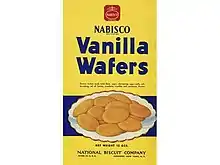Nilla
Nilla is a brand name owned by Nabisco that is most closely associated with its line of vanilla-flavored, wafer-style cookies. The name is a shortened version of vanilla, the flavor profile common to all Nilla-branded products. Originally sold as Nabisco Vanilla Wafers, the product's name was changed in 1967 to the abbreviated form Nilla Wafer.[1]
 | |
| Type | Brand |
|---|---|
| Industry | Food |
| Founded | July 10, 1967 |
| Headquarters | East Hanover, New Jersey, United States |
| Parent | Nabisco (Kraft Foods until 2012; Mondelēz International 2012-present) |
The original Nilla product is the Nilla wafer, a round, thin, light wafer cookie made with flour, sugar, shortening, and eggs.[2] Originally flavored with real vanilla, Nilla wafers have been primarily flavored with synthetic vanillin since at least 1994, a change which prompted some criticism.[3][4] Presently, Nilla wafers are described as having "natural and artificial flavor", according to the ingredients list on the box.[5]
Nilla also produces a variety of spin-off products, including pie crusts. The crusts were first introduced in 1992 alongside pie crusts flavored like two other Nabisco cookie brands, Oreos and Honey Grahams.[6]
History
The recipe for vanilla wafers or sugar wafers was first invented in the late 19th century by German-American confectioner Gustav A. Mayer on Staten Island.[7][8][9] He sold his recipe to Nabisco, and Nabisco began to produce the biscuits under the name Vanilla Wafers in 1898.[1] By the 1940s, Vanilla Wafers had become a major ingredient in the Southern cuisine staple banana pudding, and Nabisco began printing a banana pudding recipe on the Vanilla Wafers box.[10][11] The name of the product was not changed to "Nilla Wafers" until 1967.[1][12]

In 2013 the brand launched an advertising campaign on Facebook and other social media websites targeted at mothers. It was noted by the New York Times for being unique because Mondelez International, the company that Kraft created to own the brand, decided to spend all of its advertising dollars on social media rather than a combination of advertising platforms. The campaign resulted in a 9% increase in sales for Nilla.[13] Nabisco had previously used other marketing techniques to promote the brand, including in-person events such as sponsoring banana pudding pie eating contests at amusement parks.[14]
Uses
Nilla wafers are a common ingredient in banana pudding and are consequently very popular in the American South. In Atlanta and Houston, they are consistently in the five best-selling cookie brands.[15]
Despite not being officially sold in the United Kingdom, shops that specialize in imported American brands may carry them due to their popularity with American expatriates and curious locals.[16]

Nilla wafers and their branding have also made their way into scientific studies. The wafers themselves are commonly used to facilitate the oral administration of various compounds or medications to rats in testing.[17] Nilla's branding has been used to study consumer preferences about variations in packaging.[18]
References
- "Counterintuitive Wafers - December 6, 1999". archive.fortune.com. Retrieved 2017-10-08.
- Hartel, Richard W. (2006-06-06). "Cracker or cookie: What's the diff?". The Capital Times. Archived from the original on 2017-10-08 – via HighBeam.
- Hofsess, Diane (1994-02-24). "Shopping? It's Smart To Be Suspicious". Chicago Sun-Times. Archived from the original on 2017-10-07 – via HighBeam.
- Hermann, Andrew (1997-09-16). "New, improved - or just different". Chicago Sun-Times. Archived from the original on 2017-10-07 – via HighBeam.
Nilla wafers no longer have any vanilla in them.
- Bomgardner, Melody M. (2016-09-12). "The problem with vanilla". Chemical & Engineering News. 94 (36).
- "'Sinkies' Get Serious". Post-Tribune (IN). 1992-11-25. Archived from the original on 2017-10-08 – via HighBeam.
- Gould, Jennifer; Rosenbaum, Sophia (2015-02-26). "'Haunted' Staten Island mansion can be yours for $2 million". New York Post. Retrieved 2017-10-08.
- Kroessler, Jeffrey A. (August 2002). New York Year by Year: A Chronology of the Great Metropolis. NYU Press. p. 115. ISBN 9780814747506.
Gustav a. Mayer.
- "Meet Gustav A. Mayer". Zinn Brilliant. Retrieved 4 November 2019.
Mayer moved to the U.S. in the late 1850s at age 19. In the 1880s Mayer's mold-making experience led him to design a line of indirectly-lit, tin Christmas ornaments. - "Why do Southerners go bananas for banana pudding? | Southern Perspective". Pensacola News Journal. Retrieved 2019-05-03.
- Eats, Serious. "How Banana Pudding Became a Southern Icon". www.seriouseats.com. Retrieved 2017-10-08.
- Office, Library of Congress Copyright (1967). Commercial Prints and Labels. U.S. Government Printing Office.
Nilla vanilla wafers are the same sweet Nabisco vanilla wafers with a brand new name.
- Segal, David (2 November 2013). "Riding the Hashtag in Social Media Marketing". New York Times. Retrieved 6 October 2017.
- Terry Halbert; Elaine Ingulli (1 February 2014). Law and Ethics in the Business Environment. Cengage Learning. p. 275. ISBN 978-1-305-17787-1.
- "Consumer snack preferences; Oreos still no. 1 cookie.(NEW PRODUCT ACTIVITY OUTPACING 2004)(Brief Article)". The Food Institute Report. 2005-11-14. Archived from the original on 2017-10-08 – via HighBeam.
- Overland, Martha Ann (1992-09-16). "Getting the Goods on America; British Grocery Caters to U.S. Taste". The Washington Post. Archived from the original on 2017-10-08 – via HighBeam.
- Sobolewski, Marissa; Allen, Joshua L.; Morris-Schaffer, Keith; Klocke, Carolyn; Conrad, Katherine; Cory-Slechta, Deborah A. (2016-07-01). "A novel, ecologically relevant, highly preferred, and non-invasive means of oral substance administration for rodents". Neurotoxicology and Teratology. 56 (Supplement C): 75–80. doi:10.1016/j.ntt.2016.04.002. PMC 5663185. PMID 27094606.
For example, it is common to use a wafer cookie for oral administration to mice and rats
- Roehm, Michelle L.; Roehm, Harper A. (2010-12-01). "The relationship between packaging uniformity and variety seeking". Psychology & Marketing. 27 (12): 1122–1133. doi:10.1002/mar.20376. ISSN 1520-6793.
| Wikimedia Commons has media related to Nilla. |